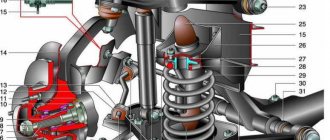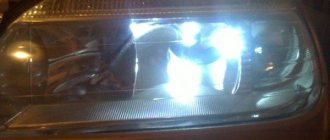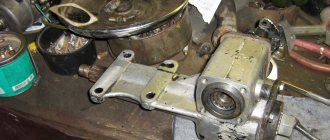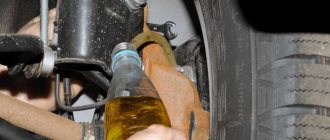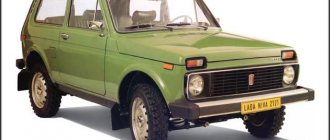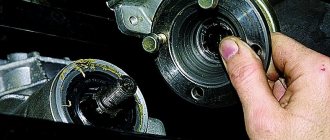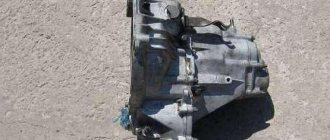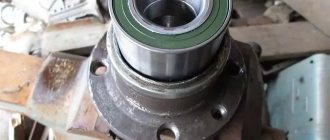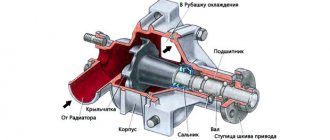The all-terrain vehicle VAZ 2121 is a reliable universal SUV. Unlike vehicles with one drive axle, it is equipped with all-wheel drive and has high maneuverability. The Niva 2121 transfer case provides conditions for operating the vehicle both on difficult roads and on city streets with heavy traffic. Thanks to the all-wheel drive wheel arrangement, a series of cars produced by AvtoVAZ became known as “Niva 4x4”.
The main purpose of the Niva 2121 transfer case
The transfer case (another name is the range multiplier) is connected directly to the gearbox, participates in the distribution of rotation on the axis of the all-terrain vehicle and helps to increase the torque when transmitted to the wheels of the vehicle.
Niva 2121 transfer case cross-sectional diagram
Transfer case functions:
- Blocking of the interaxle differential mechanism.
- Disabling one bridge.
- Increased torque transmitted to the drive wheels when turned on
- downshift.
- Distribution of torsional moment on the vehicle axle.
- Ensuring the operation of the power take-off shaft when installing additional units.
Reviews and observations
Based on the experience of owners of the Lada 4x4 SUV, a number of advantages can be identified after disabling the front axle:
- Fuel consumption can be reduced by 3 liters per 100 km. Savings in each case are individual and in some cases may be insignificant;
- Dynamics improves. The car accelerates better on dry asphalt;
- The maximum speed increases slightly;
- Less vibration, howling and hum while the car is moving.
Rear-wheel drive on the VAZ 2121 has a number of disadvantages:
- Significant reduction in cross-country ability;
- Significant deterioration in controllability. With the front axle disabled, it is very difficult to drive on a slippery road; this is facilitated by the short wheelbase of the SUV. On the VAZ 2131 the situation is a little better;
- The service life of parts is reduced. There is no safety margin for rear-wheel drive in the Niva's transmission;
- In winter, the oil freezes in a disconnected bridge, so sometimes it is very difficult to start moving after a long stay.
Why buy an all-wheel drive Niva and then disable the front axle? No need to drive an SUV outside the city? Saving on gasoline? It is worth considering whether it will be possible to reduce vehicle maintenance costs when, soon after one of the bridges is disconnected, it will be necessary to carry out premature repairs.
What do you think? Are there situations when it is advisable to disable the front or rear axle? Maybe it would be better to modify the Niva to improve its off-road characteristics? For example, install a self-locking differential or mud tires?
Key words: 4x4 gearbox
The VAZ 2121, in other words, “Niva”, entered mass production in the 70s of the last century. This car belongs to the class of off-road passenger cars. In the history of the domestic automobile industry, Niva became the first car whose design used all-wheel drive. Let's take a closer look at the transmission device. This should be done in order to understand why, given its almost 40-year history, the Niva transmission differs from many other similar vehicles equipped with all-wheel drive and the ability to shift in the classical way or using a viscous coupling.
The transmission in the Niva family (2121, 2131) is designed in such a way that all-wheel drive is supplied to 4 wheels. Also characteristic is the presence of a center differential. The transmission includes a gearbox, a transfer mechanism, a pair of cardan shafts, and both axles. A characteristic feature of the 2131 model is its elongated body. Otherwise, the main similarities with the first model can be traced throughout. Torque is transmitted from the engine through the gearbox to the transfer case, and it, in turn, transmits torque to the axles.
Then it goes through the cardan shafts to the gearboxes. The front gearbox transmits torque to the wheels through the differential and constant velocity joints. Likewise for the rear, also protruding, driving wheels. It is precisely because the torque is distributed to 4 wheels simultaneously that the drive is called full drive. The designation is as follows – 4WD. Another domestic car, designed on a similar principle to the Niva, is the UAZ.
Read more: Fbs4 mercedes what is it
Niva 2121 transfer device
The Niva SUV transfer case includes:
- shafts – drive, intermediate, rear and front axle drives;
- differential mechanism;
- gear shift clutch.
Two gear wheels, rigidly located on the drive axle of the transfer case, are designed to engage high or low gears. When manufacturing the drive shaft, special heat treatment is carried out in places where the greatest load from operating gears is expected. This is necessary to ensure sufficient shaft strength in order to eliminate possible defects when operating the vehicle in extreme conditions.
The transfer case gears are designed with straight and oblique teeth arranged in two rows. The helical teeth of the wheels are in constant mesh with the corresponding gears, tightly seated on the intermediate shaft. Direct - connected to the mode switching clutch. The clutch has three working positions: middle - neutral and connection with one of the two gears on the drive axle.
Driving a car
| GENERAL INFORMATION |
SHIFTING GEARS OF A MANUAL TRANSMISSION
To engage 5th gear, you must move the lever to the right, overcoming resistance, then move it forward. Reverse gear is engaged only when the car is stationary and not earlier than three seconds after squeezing the clutch pedal.
| The position diagram of the manual transmission control lever is printed on top of its handle. |
| EXECUTION ORDER |
| 1. Overcoming resistance, move the lever to the right, then move it back. |
| 2. If you cannot select the desired gear, return the lever to neutral, release the clutch pedal, then depress it again and try to select a gear again. |
SWITCHING TRANSFER CASE MODES
Using the transfer case control lever, the driver can choose between normal and all-wheel drive driving modes.
| When selecting the all-wheel drive mode (“4H” or “4l”), the warning lamp (16) lights up on the vehicle’s instrument panel. |
The transfer case does not have a neutral position, so its control lever must always be securely installed in one of the possible three positions (“2h”, 4H or “4l”). The “2H” mode is designed for vehicle movement on normal road surfaces, providing maximum fuel economy and minimal background noise. When turning on this mode, you must disable the manual locking of the front wheel hubs (models with manual locking of the hubs - see below). The “4H” mode provides optimal conditions for driving on wet or icy road surfaces. Don't forget to turn on the manual locking of the front wheel hubs. The vehicle speed should not exceed 100 km/h (60 mph). The “4l” mode provides maximum engine output power and is intended for use when driving a vehicle in mountainous terrain, off-road, sand, mud or deep snow. Manual locking of the front wheel hubs must be turned on. The vehicle speed should not exceed 40 km/h (25 mph). Shifting the transfer case control lever does not require depressing the clutch pedal. Switching from the “2H” mode to the “4H” mode on the move is only possible if the manual locking of the front wheel hubs is already turned on (models with manual hub locking). Warning
Under no circumstances switch the transfer case from the “2H” mode to the “4H” mode while driving if the manual or automatic locking of the front wheel hubs is not enabled! The gearbox can be switched from “4H” mode to “2H” mode at any vehicle speed, without the need to depress the clutch pedal. Warning
Switching the transfer case from the “4H” mode to the “4l” mode and back should only be done with the vehicle stationary! Models with automatic front wheel hub locking
| Possible positions of the control lever are indicated on the top of its handle. | The front wheel hubs of such models are marked accordingly. |
| EXECUTION ORDER |
| 1. To engage the hub lock, stop the vehicle and move the transfer case control lever to the “4h” or “4l” position. |
| 2. The blocking will occur automatically when the car starts moving. Comment |
Even if the lever is turned to the “2h” position, the hubs will remain locked until the direction of travel is changed.
When the transfer case is turned on in the “4h” or “4l” mode, the hub locking is turned off instantly and turns back on when the direction of movement changes.
Models with manual hub locking
To disengage the clutch lock, turn it counterclockwise and bring it to the “free” position (see ibid.).
FEATURES OF DRIVING 4WD VEHICLES
Driving on the highway in the cold season
The increased traction of all-wheel drive models provides the vehicle with better handling when driving in difficult road conditions, particularly in deep snow and heavy icing. However, all-wheel drive does not provide anti-skid protection in any way. Moreover, it is often easier to get a rear-wheel drive or front-wheel drive car out of a skid than in the case of 4wd models. In view of the above, you should not abuse the inclusion of all-wheel drive modes when driving on shallow snow or ice crust. – Depending on the specific conditions, switch the transfer case to the “4l” or “2h” mode; – Start the engine, engage a low gear and start moving at the lowest possible speed, manipulating the gas and clutch pedals; – Try to avoid excessive clutch slipping; – Try to shift the transmission into higher gear as quickly as possible and make sure that the engine speed does not increase excessively.
Off-road driving
When the deterioration of the road surface makes it necessary to engage the all-wheel drive mode, try to comply with the following basic requirements: – Drive reasonably slowly, in low gears, taking into account the road and weather conditions; – To drive the car, try to use the gas pedal, minimizing the use of the brakes; – Try to avoid slipping of the clutch and turning the wheels; – Avoid sharp turns of the steering wheel. Try to take into account all weather and road factors - use common sense and try to soberly assess the capabilities of the car. Before you go on a long trip, plan your route in advance. Before departure, check the technical condition of the car.
OVERCOMING WATER OBSTACLES
Try not to go into deep water. Before starting the crossing, study the bottom relief of the obstacle and choose the most gentle entry into the water. Switch the transfer case to the “4l” position and engage first gear. Try not to allow the engine speed to jump to prevent water from entering the exhaust system if the exhaust pipe cut is below the surface. Drive at a speed of no more than 5 km/h (3 mph) and try not to create a lot of splashes. Try not to move against the current. If this is not possible, try to turn the car at such an angle to the current vector that the incoming water does not pour into the engine compartment. Avoid splashing into the engine compartment to prevent engine shutdown due to moisture in the ignition system components. Make sure that water does not get into the engine air intake, as this can lead to jamming and the need for expensive repairs. After successfully overcoming a water obstacle, check the proper functioning of the brakes. To speed up the drying of the working surfaces of the brake mechanisms, slow down the car several times while driving at low speed. As soon as possible, check whether water has entered the air cleaner filter element, the engine, transmission, axle housings, or the vehicle interior. Replace any lubricants that have acquired a milky consistency, which is evidence of water getting into the oil.
Handout operation on Niva 2121
By analogy with the gearbox, the transfer case on the Niva Chevrolet jeep also has gears. When the corresponding gearing of the gears on the shafts is engaged, gear ratios equal to 1.2 and 2.135 are provided. Using a differential mechanism, the redistribution of torsional moment between the wheels is ensured, in accordance with their resistance to movement.
The operation of the transfer case, while the VAZ Niva SUV is driving on a dry, flat highway, the wheels of the car rotate at the same speed. In this case, the gears are not engaged, the gears and clutch are in the neutral position. As soon as the vehicle's driving conditions worsen, the transfer case on the Niva turns on. The driver uses a special lever to downshift the transfer case so that the SUV confidently continues moving at a stable speed.
How the transfer case works on the Niva 2121 in extreme off-road conditions. Experienced car enthusiasts know how to professionally use a transfer case on a Niva. They know that in such situations they need to use levers to lock the differential gears. This is necessary to ensure uniform rotation of both shafts of the vehicle’s drive axles in order to create increased cross-country ability of the vehicle.
Important: The transfer case is switched to a lower gear only after the Niva 2121 SUV has come to a complete stop (not while driving).
On a Chevrolet Niva, switching the transfer case is used as follows
- Lock and reduced speed, activated to overcome mud, slippery slopes or difficult snowy areas.
- Reduced speed with an unlocked differential is activated when overcoming obstacles and inclines on hard surfaces.
- The first speed with the differential unlocked is engaged when driving on a flat road (highway). It is not recommended to use the lock mode on roads with good grip, as this will accelerate tire wear, increase the load on parts and gearboxes and increase fuel consumption.
The operating principle of all-wheel drive (unlocked differential) in a Chevrolet Niva
In normal mode, the Chevrolet Niva operates in high gear with the differential unlocked. Torque is transmitted from the drive through the gearbox and intermediate shaft to a two-speed transfer case. The center differential is built into the transfer case. It connects the front and rear axles and allows them to turn at different speeds depending on road conditions and direction of travel.
How does all-wheel drive work on a Niva with a locked differential?
When all-wheel drive is engaged, both propeller shafts are locked by a locking clutch. This promotes uniform transmission of traction to both axles of the vehicle. Because of this, the vehicle's cross-country ability increases, but controllability deteriorates.
Description of possible problems with the transfer case
During the operation of off-road vehicles, parts and components of the transfer case gradually become unusable due to wear. Most often, the following interruptions in the operation of the mechanism occur:
- The front axle does not engage.
- The transfer case is overheating.
- Leaks and increased oil consumption of the transfer case.
- Unauthorized disabling of the front axle.
Changing the oil in the transfer case Niva 2121
To ensure the performance of the vehicle, it is necessary to carry out timely maintenance. Changing the oil is included in the mandatory list of machine maintenance work. To change consumables in the Niva 2121 transfer case, you will need 0.8 - 1.5 liters of gear oil.
Diagnostics and repair of the speed box
To carry out a full diagnosis, the speed box must be removed. As a rule, there is a need for this if vibrations, extraneous noise, or oil leakage increase during movement.
How to remove the box? Before you begin removing the gearbox, you must remove the transfer case. Without an inspection hole, it will be difficult to carry out repair work, for example, unscrewing the cardan shafts from the transfer case. The stabilizer can also be removed. The housing of the air filter element must be removed.
In order to remove the gearbox, you should disconnect the lever rod, the clutch housing cover fastenings, the driveshaft, bolts, nuts, and remove the bracket. The suspension of the power unit is adjacent to the body. To remove it you need to unscrew the fastening nuts.
To extend the service life of the VAZ 21213 gearbox, it is advisable to periodically check the level of transmission fluid and change it in a timely manner.
It should be noted that often the appearance of extraneous noise from the gearbox is a consequence of the fact that there is a low level of transmission oil in the system.
Mineral oil can be added to the machine. However, semi-synthetic and synthetic options have better performance. The advantage of the latest types of oils is that even in winter the gears will be easily engaged.
Timely maintenance of the Niva gearbox allows you to avoid a complete overhaul of the gearbox. Assembling all the dismantled parts is a painstaking task, so it should be trusted to professionals. Replacing the gearbox input shaft bearing is a common procedure that is ordered at a service center.
Didn't find the information you are looking for? on our forum.
